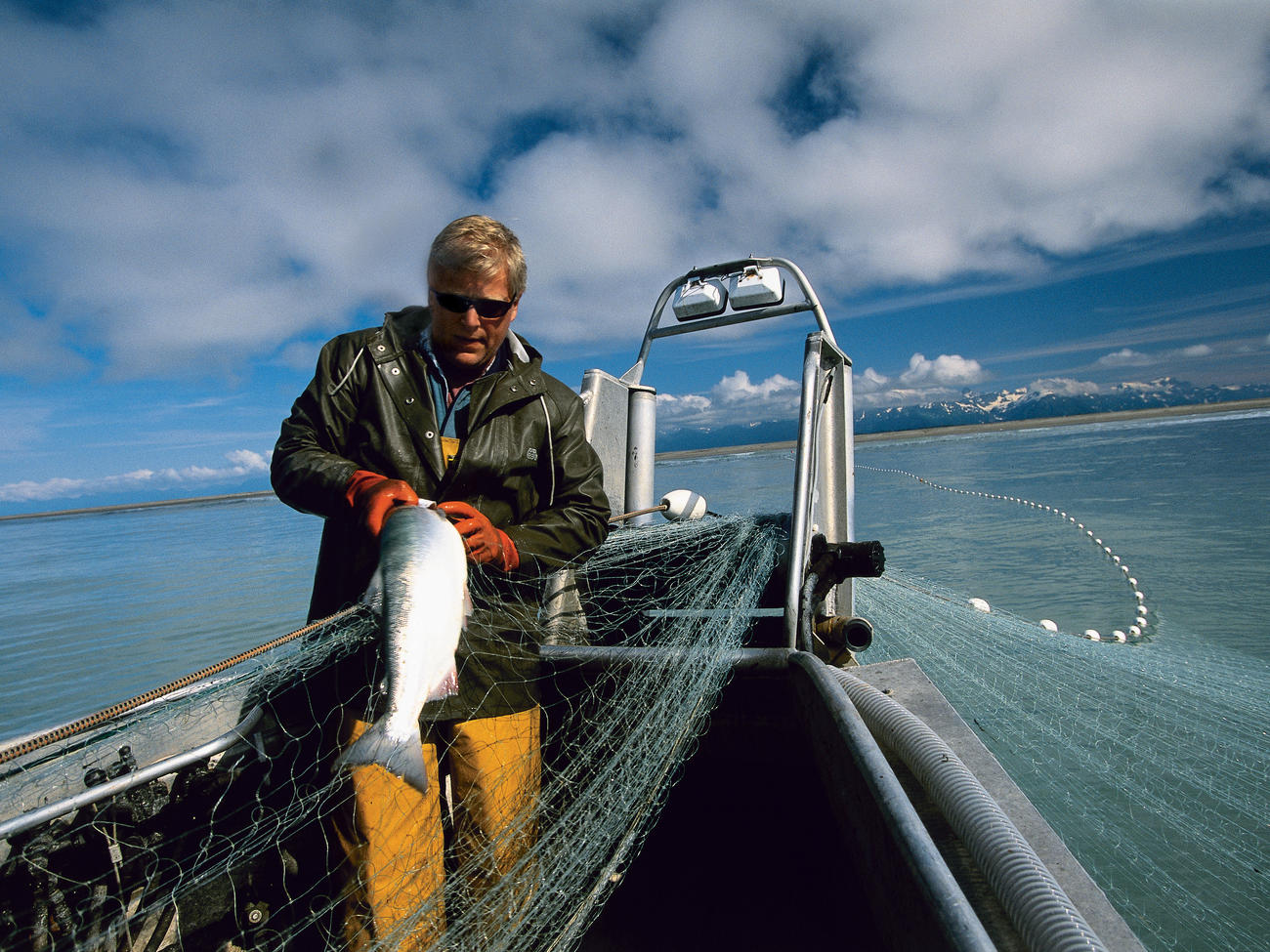
Running Wild

“This is going to be tricky,” says George Covel as he guns the engine of his 30-foot aluminum jet boat and turns toward the beach. Cresting over the back of a wave, the boat plunges into a trough and rides up the back of another swell, crashing through into another trough. The deck is awash with the cold, gray waters of Alaska’s Copper River Delta.
Tucked into the remote southeast corner of Alaska’s Prince William Sound, the delta is a 700,000-acre wetland of rivers, sloughs, and ponds that, in spring, make up one of North America’s major waterfowl staging areas.
The delta is dominated by the Copper River―itself roughly 10 miles wide near its mouth―which pours into the Gulf of Alaska between massive, ever-shifting islands of sand the river has carried from glaciers far upstream.
In one of the wildest and most unforgiving places on the planet, these are the waters Covel and the fishing fleet of the town of Cordova ply for Copper River salmon, a fish valued by chefs for a flavor and texture that are distinctive to this glacial river. These qualities are so prized that the Copper River king commands more than $20 per pound at the market.
Ever since the last Ice Age, salmon have returned to Western rivers to battle their way upstream―in some cases traveling more than a thousand miles―to spawn and then die. It is an annual rite that has sustained wildlife ranging from bears to bald eagles. And salmon have nourished many Native American tribes for countless generations―as food, as artistic inspiration, and as a religious symbol. The salmon is as much an icon of the West as the grizzly bear.It wasn’t all that long ago that these fish teemed in most of the West’s coastal rivers and were the mainstay of a major industry.
Today, runs of wild salmon are fast disappearing from rivers in Washington, Oregon, and California. Overfishing, dams, development, pollution, and water diversions have all taken their toll on the West’s once-thriving fishing industry. Alaska may stand as the last viable wild salmon fishery. And here, in this overlooked corner of our largest state, may lie the best hope for the future of wild salmon.
Following the fleet
The sockeye fishing in the delta that morning had been lousy. “We’ve missed the tail of the run,” Covel had shouted above the roar of the boat as he steered us to the rougher seaward side of Grass Island. The Copper isn’t Alaska’s longest river, but it is big, fast, and, because it’s mostly glacier-fed, cold. Salmon here pack a lot of extra fat for the arduous trip back to their ancestral spawning beds and for that reason have a very high oil content, giving Copper River salmon their renowned firm, deep-red flesh and rich flavor.
The commercial salmon-fishing season isn’t allowed to start here until the Alaska Department of Fish and Game gives the go-ahead. A sonar station 30 miles upriver, at the Million Dollar Bridge, tracks the runs, and once it shows that enough fish are making it upstream to spawn, the commercial fishery can operate for periods of at least 12 hours before stopping to allow the upriver count to rise again.
Covel is not happy with Fish and Game. “They want the official count of fish passing the sonar station,” he says. “Problem is, it takes the fish a week to get up the river to the sonar. By then it’s over down here.”
Dan Gray is the state fisheries biologist who helps decide when the sonar count is high enough to permit fishing; he’s not in an enviable position. “When I took this job, I was introduced at a community meeting as the most powerful man in town,” he says. “What it means is that I’m not the most popular man in town.”
For Gray, it all boils down to numbers. Last year, for example, the goal was to allow 651,500 fish to go upriver: 317,500 to spawn and sustain the runs, the rest reserved for the federal- and state-determined subsistence catch, which was increased recently to allow more Alaskans to take hundreds of fish for personal use. “Salmon returns naturally fluctuate in 30-year cycles, so a period of low returns doesn’t leave much for the commercial fishery,” Gray acknowledges.
Wild versus farmed
When Covel said he’d try his luck close to the beach, he meant it; the crash of the surf is loud when he finally stops the boat. Releasing the net buoy from the bow, he begins feeding out 900 feet of net as he reverses the engine and bulldozes backward through the breakers. Spray breaks over the boat’s stern. “Conditions out here can be treacherous,” says Covel. “It seems like we still lose one or two guys every year.”
Despite its prominence, the Copper River fishery is―like many Western salmon fisheries―mostly a mom-and-pop industry. Many of Cordova’s 500 boats are like Covel’s―rugged gill-netters that one person can work.
Slipping on gloves, Covel throws a lever, and the net winds back over the bow, the pale green folds of mesh glistening like lacework. Then, almost magically, a salmon flops over the net roller and onto the deck. Blue-backed and silver-bellied, it thrashes and flashes in the light. There’s another one, then another.
Covel, who’s been working the delta for 12 years, has seen the commercial fishery’s decline. While commercial fishermen netted nearly 1.8 million salmon from the Copper River in 2002, they’re still hurting―in large part because of consumers’ attraction to cheaper farmed salmon, the world supply of which more than tripled between 1989 and 1998. While prices for the early-season run of the prized king (or chinook) salmon remain high, the farmed-salmon glut has depressed prices for the later runs of sockeye (or red) and silver (or coho) salmon. It is only people’s willingness to pay more for quality wild salmon that keeps Covel’s boat running.
And that’s how the dominoes begin to fall: without a healthy fishing industry, there’s less economic incentive to maintain a healthy watershed. Or to preserve wild salmon.
